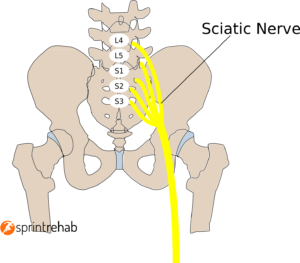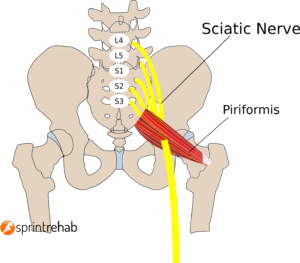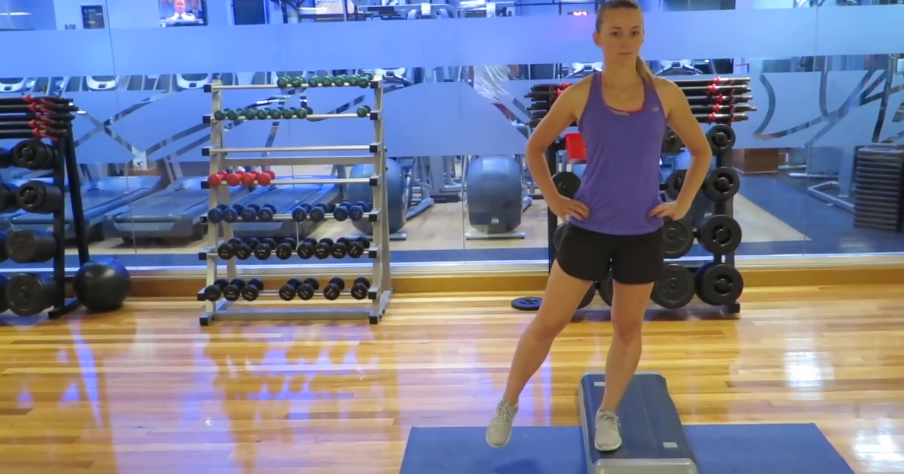by Alina Kennedy, special to SportsMD.com
 Pinching, sharp pain in the backside and shooting pain down the leg are typical symptoms of sciatica – a condition caused by an irritated sciatic nerve.
Pinching, sharp pain in the backside and shooting pain down the leg are typical symptoms of sciatica – a condition caused by an irritated sciatic nerve.
The sciatic nerve is the largest nerve in the human body, starting in the spine and traveling down the leg with a diameter of up to 2cm.
This large nerve is closely entwined around spinal joints and muscles along its path. It originates next to spinal discs, passes through vertebrae and weaves in and out of muscles.
The sciatic nerve can get irritated by any of the structures it passes along its path. A bulging disc, inflamed joint or spasming muscle can all cause sciatica by irritating the sciatic nerve. Please note that the sciatic nerve is not damaged or blocked. Sciatica is a temporary condition caused by inflammation. Once the cause of the inflammation is fixed, the pain will go away.
What Causes Sciatica in Runners?
 The most common cause of sciatica in runners is a tight Piriformis muscle.
The most common cause of sciatica in runners is a tight Piriformis muscle.
The piriformis a small muscle deep in your buttocks. It helps you balance on one leg and also rotates your hip.
The sciatic nerve passes straight through the piriformis muscle. If the piriformis goes into spasm, it can irritate the sciatic nerve and send pain along the nerve’s path (buttocks and down the leg). This is called Piriformis Syndrome.
In runners, the piriformis is particularly susceptible to spasm because of overuse and fatigue. When running, your piriformis works hard every time your foot hits the ground. Together with other stabilizing muscles like the glute minimus and glute medius, the piriformis makes sure your hip and pelvis stay balanced, upright and supported as you absorb each landing.
If you’re new to running or training at a new level, your piriformis might not be ready to take on all this work. As the piriformis gets fatigued, over-worked and irritated it will seize up, compressing the sciatic nerve that passes straight through it.
How to Tell If Your Sciatica is Coming From the Piriformis

Because sciatic pain can be caused by any number of structures that interact with the sciatic nerve, it’s important to identify the root cause of the pain before starting treatment. Physiotherapists and Sports Physicians go through a thorough assessment process to identify the cause of pain – they will take a detailed history, look at your movement and possibly get scans to look closer at your anatomy. All of these tests help to form a clear picture of what is causing your pain. One of the most important aspects of this assessment is identifying a pattern of symptoms and comparing that with what we know is typical for Piriformis Syndrome.
There are a few telltale symptoms of Piriformis Syndrome that differentiate it to other causes of hip pain and other types of Sciatica. For example, people with Piriformis Syndrome typically have the following symptoms:
– Sharp pain in the buttocks
– Increased pain with prolonged sitting
– Increased pain when walking or running uphill (or upstairs)
– Decreased flexibility (range of movement) in the hip
Sciatica that originates in the spine tends to present with a slightly different set of symptoms that are more localized to the lower back. If you suspect you have sciatica or piriformis syndrome, you should see a Physiotherapist or doctor who can perform the necessary diagnostic tests and prescribe an propriate treatment plan.
How is Piriformis Syndrome Treated?
Once you’ve been diagnosed with Piriformis Syndrome, the treatment plan will be two fold; the first priority will be relaxing the piriformis, the second will be strengthening the piriformis and all the surrounding muscles.
There are a number of ways the piriformis muscle can be relaxed. Here are some of the options you may be presented with:
– Deep sports massage
– Glute stretches
– Dry needling
– Self-massage
Each of these treatment options can be effective for you so it’s important to choose something you’re comfortable with. You should expect to see some improvement within the first couple of weeks, if not, try another option.
The second part of treatment will involve strengthening the piriformis and surrounding muscles. It’s important to build these muscle to better tolerate the stress and endurance of running. Balance and stability exercises like this hip control routine are perfect (click here or the image to play video):

Once the pain has decreased and you are doing regular strengthening exercises, you can gradually resume your normal running routine. However, be aware of any changing in symptoms and if you notice the pain returning, see your Physio or doctor.
Get a Virtual Sports Specialized appointment within 5 minutes for $29
 When you have questions like: I have an injury and how should I manage it? How severe is it and should I get medical care from urgent care center or hospital? Who can I talk to right now? SportsMD Virtual Urgent Care is available by phone or video anytime, anywhere 24/7/365 and appointments within 5 minutes.. Learn more via SportsMD’s Virtual Urgent Care Service.
When you have questions like: I have an injury and how should I manage it? How severe is it and should I get medical care from urgent care center or hospital? Who can I talk to right now? SportsMD Virtual Urgent Care is available by phone or video anytime, anywhere 24/7/365 and appointments within 5 minutes.. Learn more via SportsMD’s Virtual Urgent Care Service.
Alina Kennedy is a Physiotherapist, Strength & Conditioning Specialist and avid runner with over 10 years clinical experience. She is also the founder of Sprintrehab.com, a website providing Physio rehab and strength training exercise programs for runners.
Alina graduated from the University of South Australia. After moving from her home town of Adelaide, Alina spent 4 years living in Sydney working in several sports Physiotherapy clinics. She’s now based in New York City and works exclusively with runners on all things rehab and performance.
Cover Image: Pixabay/StockSnap
